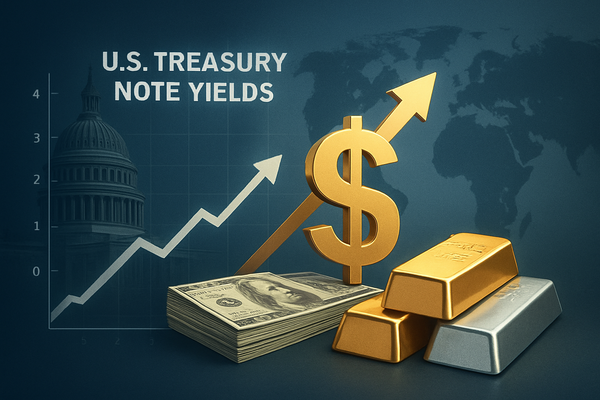Gold Soars to $4,030/oz as U.S. Manufacturing Contracts, Signaling Deepening Economic Concerns

New York, NY – November 3, 2025 – Spot gold prices have surged to trade near an unprecedented $4,030 per ounce, a significant milestone that underscores a growing sense of economic unease among investors. This remarkable rally in the precious metal comes on the heels of the October ISM Manufacturing Purchasing Managers' Index (PMI) falling to 48.7, signaling an eighth consecutive month of contraction in the crucial U.S. manufacturing sector. The dual movement highlights a clear flight to safety, as investors increasingly seek refuge in gold amidst concerns over a weakening economy and the potential for shifts in monetary policy.
The confluence of a contracting manufacturing sector and soaring gold prices paints a stark picture of the current economic climate. A PMI reading below 50 indicates contraction, and October's 48.7 not only missed expectations but also deepened the ongoing downturn, suggesting a more entrenched slowdown than previously anticipated. This economic indicator, widely considered a bellwether for the broader economy, is fueling speculation that the Federal Reserve may be compelled to adopt a more dovish stance on interest rates, further bolstering gold's appeal as a non-yielding asset.
Detailed Coverage: Manufacturing's Contraction and Gold's Ascent
The U.S. Institute for Supply Management (ISM) Manufacturing PMI for October 2025 registered 48.7, a decline from September's 49.1 and below economists' consensus forecast of 49.5. This marks the eighth consecutive month that the index has remained below the critical 50-point threshold, firmly placing the sector, which accounts for approximately 10.1% of the U.S. economy, in a state of contraction.
Specific details within the October report revealed broad-based weakness. Key sub-indices such as production, new orders, and employment all contracted, contributing to the overall decline. While the new orders sub-index saw a slight increase to 49.4 from 48.9, it remained in contractionary territory for eight of the last nine months, indicating persistently subdued demand. Manufacturers reported ongoing challenges including tariffs, elevated costs, and weak demand, with many deferring capital projects and facing delayed orders, particularly in machinery, metals, and semiconductors.
This sustained downturn follows a period of consistent contraction throughout 2025. In September, the PMI stood at 49.1, the seventh consecutive month of contraction, while August recorded 48.7. The general economic environment leading up to October was characterized by an ongoing U.S. government shutdown, making it difficult to ascertain a clear economic picture, alongside persistent issues like tariffs and high input costs.
Key players in this unfolding scenario include the Institute for Supply Management (ISM), which compiles this vital economic report. The Federal Reserve closely monitors these indicators to inform its monetary policy. Despite a recent 25 basis point rate cut in October, Chair Jerome Powell has maintained a cautious stance on further reductions, emphasizing the need for clearer economic data. Investors have reacted by flocking to safe-haven assets, with spot gold prices surging to trade near $4,030 per ounce immediately following the report's release. This surge is attributed to heightened economic uncertainty, driving robust demand for gold. Concurrently, the U.S. dollar faced downward pressure, as a weak PMI typically suggests a potential slowdown and increases the likelihood of future rate cuts.
Corporate Impact: Winners and Losers in a Shifting Landscape
The current economic environment, marked by soaring gold prices and a contracting manufacturing sector, creates a clear dichotomy of winners and losers among public companies.
Winners: Gold Mining Companies Gold mining companies are the primary beneficiaries of gold prices trading near $4,030/oz. Higher gold prices directly translate to increased revenues and expanded profit margins, assuming stable production costs. This operating leverage significantly boosts profitability, cash flow, and ultimately, stock valuations for efficient miners. Elevated prices can also make previously uneconomical deposits viable and stimulate exploration.
Leading public companies poised to benefit include:
- Newmont (NYSE: NEM): As the world's largest gold producer, Newmont's extensive operations will see a substantial boost in revenue and profit margins.
- Barrick Gold (NYSE: GOLD): Another major global gold miner, Barrick will experience a direct and significant increase in its financial performance.
- Agnico Eagle Mines (NYSE: AEM): This Canadian-based producer will capitalize on the operating leverage from higher gold prices.
- Kinross Gold (NYSE: KGC): With operations across the Americas and Africa, Kinross's earnings and cash flow will be significantly enhanced.
- AngloGold Ashanti (NYSE: AU): A prominent South African producer, AngloGold Ashanti will also see a positive impact on its profitability.
- Alamos Gold (NYSE: AGI): This company has historically shown a strong correlation between rising gold prices and improved earnings.
Losers: Industrial and Manufacturing Companies A falling ISM Manufacturing PMI signals reduced industrial output, declining new orders, and potential negative impacts on employment. This economic slowdown translates to decreased demand for manufactured goods and reduced capital expenditures across various industries.
Companies likely to face headwinds include:
- Caterpillar Inc. (NYSE: CAT): As a leading manufacturer of construction and mining equipment, Caterpillar will likely see reduced demand for its heavy machinery.
- Deere & Co. (NYSE: DE): Producing agricultural and construction machinery, Deere will experience decreased sales due to lower investment by businesses.
- Honeywell International (NASDAQ: HON): This diversified conglomerate, with segments in aerospace and industrial technologies, will likely see reduced orders.
- 3M Company (NYSE: MMM): As a global diversified manufacturer, 3M's broad range of industrial products will experience weakened demand.
- Illinois Tool Works Inc. (NYSE: ITW): Manufacturing specialized industrial equipment, ITW will directly suffer from reduced activity.
- Parker-Hannifin Corp (NYSE: PH): A producer of motion and control technologies, Parker-Hannifin will see decreased demand for its components.
- Transportation and Logistics Companies like Union Pacific Corp (NYSE: UNP), CSX Corp (NASDAQ: CSX), FedEx Corp (NYSE: FDX), and United Parcel Service Inc. (NYSE: UPS) will face reduced freight volumes due to lower production and movement of goods.
Other Losers: Companies Using Gold in Manufacturing Approximately 11% of all gold produced is used in industries like electronics, dentistry, and aerospace due to its unique properties. Companies in these sectors face a double challenge: increased input costs from higher gold prices and reduced demand due to the broader manufacturing contraction. Examples include:
- Electronics Manufacturers like Intel (NASDAQ: INTC) or Apple (NASDAQ: AAPL) (and their supply chains) will see increased costs for gold used in circuit boards and connectors.
- Aerospace & Defense Contractors such as Lockheed Martin Corp (NYSE: LMT) and Boeing Co (NYSE: BA) use gold in critical components, facing higher material costs.
- Medical Device Manufacturers also use gold, and will see increased material costs for specialized products.
Wider Significance: Economic Headwinds and Policy Responses
The simultaneous surge in spot gold prices to near $4,030/oz and the persistent contraction in the ISM Manufacturing PMI signal a profound shift in the economic landscape, characterized by heightened uncertainty and a flight to safety. This scenario fits into broader industry trends reflecting widespread unease over the U.S. economy, geopolitical instability, and concerns about monetary policy.
Gold's unprecedented rally is driven by its traditional role as a safe-haven asset, protecting wealth during financial and geopolitical turmoil. Expectations of continued monetary policy accommodation, such as potential interest rate cuts by central banks, further bolster gold's appeal by reducing the opportunity cost of holding the non-yielding asset. Moreover, a weakening U.S. dollar, concerns about currency debasement amidst ballooning federal debt, and significant gold accumulation by global central banks contribute to its upward momentum.
Conversely, the manufacturing downturn, with the PMI consistently below 50, is a critical leading indicator of overall economic health. Persistent contraction often precedes or signals a broader economic slowdown, potentially leading to a recession. This deceleration impacts new orders, production, employment, and creates challenges within supply chains. The current interplay suggests strong investor sentiment towards economic headwinds and risk aversion, potentially raising concerns about stagflation – a period of slow economic growth combined with high inflation – an environment in which gold has historically performed well.
The ripple effects extend beyond direct manufacturers. Supply chain disruptions, reduced corporate earnings for industrial firms, and intensified competition are likely. Industries reliant on manufactured goods, such as technology and automotive, will face delays and higher input costs. Even luxury goods and jewelry brands, despite gold being a smaller component of their final product, will contend with increased production costs, potentially leading to price hikes or shifts in material usage.
In terms of regulatory and policy implications, central banks, particularly the U.S. Federal Reserve, will likely face pressure to consider further interest rate cuts to stimulate economic activity. Governments may also deploy fiscal stimulus measures, such as increased spending or targeted tax cuts. There might also be a re-evaluation of trade policies to alleviate economic uncertainty and support industrial growth, alongside initiatives to strengthen supply chain resilience.
Historically, the combination of a strong gold rally and economic downturns has several precedents. The 1970s stagflation era saw gold surge amidst high inflation and stagnant growth. During the 2000 tech bubble burst, gold began a multi-year bull run. The 2008 Global Financial Crisis and the 2020 COVID-19 pandemic also witnessed significant gold rallies as investors sought safety. These historical parallels underscore gold's established role as a crisis hedge, although today's complex global economy, with geopolitical fragmentation and central bank demand, adds new dimensions to its significance.
What Comes Next: Navigating Uncertainty
The current market dynamics, characterized by gold's surge and manufacturing's slump, point to a period of continued economic uncertainty, demanding strategic pivots from businesses and careful navigation by investors.
Short-Term Outlook: Gold may see some consolidation, but continued weak economic data, particularly in employment or consumer spending, will likely sustain strong demand, potentially pushing prices higher. Geopolitical turbulence and inflationary expectations will also provide support. The manufacturing sector, however, is expected to continue its slowdown due to macroeconomic headwinds, labor challenges, and geopolitical uncertainties, although some internal PMI components hint at a possible future rebound.
Long-Term Outlook: The long-term trajectory for gold remains bullish, with some analysts forecasting prices to reach $5,000 by mid-2027 and potentially $10,000 by the end of 2034, driven by persistent global uncertainty, robust central bank purchases, and fiscal deficits. The manufacturing sector, while facing challenges, is at a critical juncture to adapt through investments in AI, clean technology, and workforce innovation, with trends like reshoring and nearshoring gaining traction.
Strategic Pivots and Adaptations: Manufacturing businesses must prioritize supply chain resilience, embrace advanced technologies like AI and robotics for efficiency, and invest in workforce development to address labor shortages. Operational efficiency and exploring new, less cyclical markets will be crucial. Investors should re-evaluate portfolios, potentially increasing exposure to precious metals through ETFs, mutual funds, or gold mining stocks, and consider diversifying into other alternative assets if gold's momentum cools.
Market Opportunities and Challenges: Opportunities lie in gold's sustained demand and potential for long-term appreciation, benefiting gold mining companies. For manufacturing, strategic investments in AI and clean tech, coupled with reshoring trends, offer growth avenues. However, challenges include persistent economic uncertainty, volatile commodity prices, labor shortages, and the impact of high gold prices on manufacturers using the metal as an input.
Potential Scenarios: Several outcomes are possible: a "soft landing" where the economy avoids deep recession and gold moderates; a "hard landing" with significant contraction, driving gold even higher; a "sustained accommodation & elevated inflation" scenario where central bank easing fuels gold further amidst persistent inflation; or an "economic stabilization & moderate inflation" scenario, offering a more predictable environment for manufacturing. The interplay between a contracting manufacturing sector and soaring gold prices underscores an economy grappling with profound uncertainty.
Comprehensive Wrap-Up: A Market at a Crossroads
The current financial landscape is undeniably shaped by two powerful, contrasting forces: the exceptional surge of spot gold to near $4,030/oz and the troubling contraction of the U.S. manufacturing sector, as indicated by the October ISM Manufacturing PMI of 48.7. This scenario paints a vivid picture of heightened economic uncertainty, prompting a significant flight to safety among investors.
Key Takeaways from this period include gold's undeniable status as a premier safe-haven asset, its rally fueled by anticipated dovish shifts from the Federal Reserve, persistent inflation concerns, and ongoing geopolitical tensions. Concurrently, the manufacturing downturn signals deepening economic headwinds, impacting production, new orders, and employment, and raising concerns about broader economic challenges, potentially including a recession. The direct correlation between manufacturing weakness and gold's strength suggests that market participants are increasingly seeking the stability offered by the precious metal as traditional economic indicators falter.
Moving Forward, the market is expected to remain volatile. The outlook for gold remains largely bullish, supported by structural supply constraints and continued global uncertainty. However, the broader economic implications of a sustained manufacturing contraction could lead to reduced consumer demand and a flight to defensive sectors in equities. Central banks will be under immense pressure to respond to slowing economic data, with their statements on future monetary policy easing being a primary driver for both the dollar and gold.
The lasting impact of this period could be a redefinition of how investors perceive risk and value. The strong performance of gold at such elevated levels suggests a deeper, structural shift in investor psychology, emphasizing diversification and the enduring appeal of tangible assets. A prolonged manufacturing downturn could also accelerate long-term shifts towards service-based economies, with potential social and economic consequences for manufacturing-dependent communities.
What investors should watch for in the coming months includes continued monitoring of ISM Manufacturing and Services PMI reports for signs of stabilization or further contraction. Inflation data (CPI, PPI) will be crucial for understanding central bank policy, while Federal Reserve statements on interest rates will significantly impact market direction. Employment data, consumer confidence indices, and quarterly GDP growth reports will provide comprehensive insights into the overall economic health. Finally, ongoing geopolitical developments will continue to influence safe-haven demand for gold. By diligently observing these indicators, investors can better position their portfolios to navigate the evolving market landscape.
This content is intended for informational purposes only and is not financial advice



